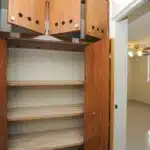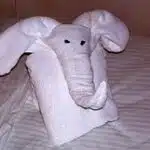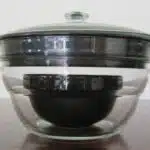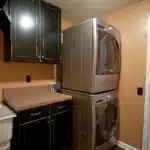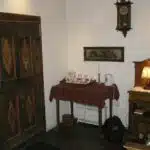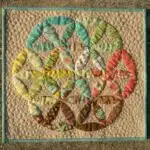Keeping a tidy and well-organized home is essential for many people. However, it can be challenging to maintain order in certain areas of the house, such as the coat closet. A cluttered coat closet can make it difficult to find what you need, and it may even cause frustration when trying to get out the door on time. Fortunately, with a little effort and organization, you can easily transform your coat closet into a functional space that allows you to quickly grab what you need and head out the door.
As a professional home organizer, I have seen firsthand how having an organized coat closet can make life easier for busy individuals. In this article, I will share some tips and tricks that will help you create an efficient system for storing jackets, coats, hats, and other accessories in your coat closet. From decluttering your existing items to utilizing creative storage solutions, these strategies will help you maximize your space while keeping everything neat and easily accessible. By following these steps, you’ll be able to create a clutter-free coat closet that not only serves its primary function but also adds value to your daily routine.
Assessing Your Needs
A coat closet is like a tiny, well-organized library that houses your outerwear. Just as libraries have different sections for various genres, a coat closet has different sections for storing different types of clothing items. Before diving into the logistics of organizing your coat closet, it’s essential to assess your storage needs and plan out the closet layout.
Assessing storage needs involves taking stock of what you own and how much space you have available. You may need to measure the length, width, and depth of your closet to determine the best way to utilize space. Consider whether you need extra shelving or hooks for accessories like hats and scarves. Assessing storage also means identifying which items are seasonal versus year-round wear.
Closet layout planning is an integral part of creating an organized coat closet. It’s crucial to separate items based on their frequency of use and accessibility. For example, coats worn more frequently should be placed in an easily accessible spot in the closet, while off-season clothing can be stored higher up or further back. Closet layout planning also involves deciding which hangers work best for each item, such as padded hangers for delicate materials or wooden hangers for heavier coats. With careful planning and consideration of storage needs and layout, organizing your coat closet will become a breeze!
As we move forward with our organizational process, it’s crucial to clear out any clutter before organizing our belongings in our freshly planned coat closets. Let’s dive into our next step: clearing out all excess items that no longer serve us in order to create a functional space that highlights only those things that spark joy!
Clearing Out The Clutter
Before you start organizing your coat closet, it is essential to declutter first. Decluttering is a process of getting rid of things that no longer serve a purpose or bring joy to your life. When it comes to coats and jackets, it’s easy to accumulate too many over the years. The key is to keep only what you need and what fits your lifestyle.
Here are some decluttering tips for your coat closet:
- Start by taking everything out of your closet and sorting through each item.
- Donate or sell any coats or jackets that you haven’t worn in the last year or two. If an item is still in good condition but doesn’t fit anymore, donate it instead of keeping it around.
- Get rid of any items that are damaged beyond repair or have lost their shape.
- Consider investing in multi-functional pieces that can be worn in different seasons and occasions.
Decluttering may seem overwhelming at first, but once you get started, it can be liberating. By letting go of items that no longer serve a purpose in your life, you make room for new possibilities.
In the next section, we will discuss how to sort your coats and jackets efficiently. By following these steps, you’ll be able to maximize the space in your closet while ensuring that every item has a designated place.
Sorting Your Coats And Jackets
After clearing out the clutter from your coat closet, the next step is to sort your coats and jackets. Start by taking everything out of the closet and sorting them into piles. One pile for coats you wear often, one for those you only wear occasionally, and another for those you no longer need or want.
Once you have sorted through your coats and jackets, it’s time to organize them in a way that makes sense to you. One popular method is color coding. This means arranging your coats by color so that they are easy to find and match with outfits. Another option is to hang jackets on one side of the closet and coats on the other.
Donating old items is an important part of organizing your coat closet. If there are any items in the pile of things you no longer need or want that are still in good condition, consider donating them to a charity or thrift store. Not only will this help someone else who may need a warm coat, but it will also free up space in your closet for items you actually use and enjoy wearing.
As we move forward with organizing your coat closet, it’s time to think about categorizing your accessories. This includes scarves, hats, gloves, and other items that accompany your outerwear. By creating designated areas for these items within your coat closet, you can easily find what you need when heading out the door on a chilly day. Stay tuned for our next section on how to categorize these accessories effectively!
Categorizing Your Accessories
As you sort through your coat closet, it’s important to remember that accessories are a crucial part of any wardrobe. Scarves, hats, and gloves not only serve a functional purpose but also add style and personality to your outfits. To keep these items organized, start by categorizing them into groups such as winter accessories, summer accessories, and formal wear.
One effective way to categorize your accessories is by color coding. This method allows for easy identification and matching with outfits. For example, if you have a red scarf, place it in the same section as other red items like a hat or gloves. With color coding, you’ll quickly be able to find the perfect accessory for any outfit without having to dig through piles of clothing.
Once your accessories are categorized, it’s time to determine the best storage solutions for them. Consider investing in small bins or drawers that can be easily labeled for each category. Alternatively, hanging organizers with individual compartments can make finding and selecting items a breeze. By keeping everything in its proper place, you’ll save time getting dressed and prevent clutter from taking over your coat closet.
As you move on to organizing your coats themselves, it’s important to choose the right hangers to avoid damage or wrinkles. Hang heavier coats on sturdy wooden hangers while lightweight jackets can be hung on thinner plastic or velvet hangers. With everything properly categorized and stored on appropriate hangers, your coat closet will become an effortless space that makes getting ready each day a little bit easier.
Choosing The Right Hangers
Choosing the right hangers for your coat closet is a crucial step in organizing it. There are different types of hangers available in the market, and each serves a specific purpose. The most common types of hangers are wooden, plastic, metal, and velvet. However, choosing the right one depends on your preferences and the type of clothes you plan to hang.
Wooden hangers are sturdy and durable but may not be suitable for heavy winter coats. Plastic hangers are affordable and lightweight but may not hold heavy garments well. Metal hangers are strong but can leave creases on clothes. Velvet hangers have a non-slip surface that keeps clothes from sliding off but may not be ideal for delicate fabrics. Consider these pros and cons of different materials when selecting the right hanger for your coat closet.
To ensure that your coat closet stays organized, it’s essential to use the same type of hanger for each item. This uniformity makes everything look neat and tidy, as well as maximizing space in your closet. It also makes it easier to find what you need without having to move things around or pull out multiple items at once.
- Use wooden or padded hangers for tailored jackets and suits.
- Use plastic or metal hangers for lightweight tops and shirts.
- Use velvet or padded hangers for dresses or delicate fabrics.
- Use specialty hangers like cascading hooks to save vertical space.
Maximizing vertical space is another important aspect of organizing your coat closet effectively. By utilizing every inch of space from top to bottom, you can fit more items into your closet without creating clutter. In the subsequent section, we will discuss how to make the most out of your vertical space by using shelves, cubbies, hooks, and other storage solutions.
Maximizing Vertical Space
Maximizing Vertical Space:
When organizing your coat closet, it’s important to consider using DIY shelving to maximize vertical space. This can be achieved by installing shelves or purchasing hanging organizers that attach to the top of the closet. Utilizing this type of storage solution will not only create more space for your coats but also allow you to store other items such as hats and scarfs.
Another great way to create more space in your closet is by investing in space-saving solutions such as cascading hangers or slimline hangers. These types of hangers save significant amounts of space by allowing you to hang multiple items on one hanger. This will reduce the amount of clutter in your closet and make it easier for you to find what you’re looking for.
Incorporating these simple yet effective techniques into your coat closet organization plan will help you maximize the vertical space available. By utilizing DIY shelving and selecting space-saving organizational tools, you’ll be able to create a more functional and organized closet that not only looks great but is also easy to maintain. In the next section, we’ll discuss how utilizing door space can further enhance your coat closet’s organization potential.
Utilizing Door Space
- When looking to maximize space in a coat closet, hanging hooks are a great way to hang outerwear and accessories off the floor.
- Shoe racks are a perfect addition to a coat closet, allowing for shoes to be neatly organized and easily accessible.
- Additionally, storage bins can be used to store items such as hats, gloves, and scarves, allowing for items to be kept neat and tidy.
- When considering hanging hooks, it is important to consider the weight of items being hung, as well as the type of wall material, to ensure that the hooks are properly secured.
- Shoe racks should be chosen to fit the available space, and should be adjustable if possible, to allow for changes in the number of shoes stored.
- Storage bins should be clearly labeled, and should not be overfilled, to ensure that items can be easily accessed and put away.
Hanging Hooks
Are you tired of your coat closet being cluttered and disorganized? One solution to maximize the space in your closet is to utilize the door. Installing hanging hooks on the back of the closet door is a great way to create additional storage for coats, hats, scarves, and bags.
When it comes to choosing the right hanging hook, consider its weight capacity and durability. You want a hook that can hold multiple items without breaking or damaging your clothes. Additionally, decorating the hooks with colorful or unique designs can add a touch of personality to your closet while also making it easier to locate specific items.
By utilizing door space through hanging hooks, you are not only creating more storage in your coat closet but also improving its overall organization. This simple addition allows for easy access to frequently used items and frees up valuable hanging space for larger coats and jackets. Start organizing your coat closet today by installing some sturdy and stylish hanging hooks!
Shoe Racks
Another way to maximize door space is through the use of shoe racks. Shoe storage can be a hassle, especially if you have a large collection that takes up valuable floor space in your closet. Utilizing a shoe rack on the back of your closet door can create additional storage while also keeping your shoes organized and easily accessible.
When choosing a shoe rack, consider its size and capacity. You want one that can hold all of your shoes without taking up too much space or causing damage to the door. Additionally, look for features such as adjustable shelves or pockets to accommodate different types of shoes.
Utilizing door space for shoe storage not only frees up floor space but also makes it easier to find and select the pair you need without having to dig through piles of shoes. With these organization tips, you can transform your cluttered closet into a functional and efficient space for all of your belongings.
Storage Bins
Utilizing door space for storage is a smart way to maximize every inch of your space. Shoe racks are one type of storage solution that can be hung on the back of your closet door to create additional shoe storage while keeping them organized and easily accessible. However, shoes are not the only item you can store on your closet door. Storage bins are another great option.
Storage bins come in various sizes and materials, making it easy to find the perfect fit for your needs. They are especially useful for storing small items that tend to get lost in drawers or scattered around shelves. Consider color coding and using a labeling system to make it easy to find what you need quickly.
By utilizing storage bins on your closet door, you can free up valuable floor space and keep all of your belongings organized in one place. Whether you need extra space for accessories, clothing items, or even cleaning supplies, there is a storage bin that will work for you. With a little creativity and some organizational tools, you can transform your cluttered closet into an efficient and functional space.
Adding Shelves And Cubbies
One of the most effective ways to organize a coat closet is by adding shelves and cubbies. This DIY project can be accomplished with basic carpentry skills, or through professional installation services. Whether you choose to do it yourself or hire a professional, there are several benefits to incorporating shelving and cubbies into your coat closet.
Firstly, shelves and cubbies provide additional storage space for your coats and other belongings. Instead of piling everything on top of each other, shelves allow you to neatly stack items in an organized manner. Cubbies, on the other hand, provide individual compartments for each item, making it easy to find what you need quickly. Additionally, shelves and cubbies can help maximize the vertical space in your closet, allowing you to store more items overall.
When considering adding shelves and cubbies to your coat closet, there are a few things to keep in mind. Firstly, consider the size of your closet and how much space you have available for shelving or cubbies. Secondly, think about the materials you want to use – wood is a popular choice for DIY shelving projects because it is durable and easy to work with. Finally, consider whether you want to go the DIY route or hire a professional installation service – while DIY shelving can save money, professional installation ensures that the job is done correctly and efficiently.
Adding shelves and cubbies is just one way to organize your coat closet effectively. In the next section, we’ll explore how using baskets and bins can further enhance your organizational efforts.
Using Baskets And Bins
Organizing with baskets and bins is a great way to maximize the space in a coat closet and make it easier to find items. Labeling the baskets and bins will help to quickly identify the items stored and access them quickly. Decorating the baskets and bins with colors or patterns will add a personal touch to the closet and can be used to categorize items. Utilizing baskets and bins to organize a coat closet can help to create an efficient and attractive storage solution.
Organizing With Baskets And Bins
Maximizing space is essential in any home, especially when it comes to organizing your coat closet. One effective way to make the most of your closet space is by using baskets and bins. These storage solutions can help you keep your items separated and easily accessible.
Color coding items is a great way to organize your coat closet using baskets and bins. By assigning a specific color to each member of the family, you can quickly grab their coats and accessories without any confusion or misplacement. Furthermore, color-coding can also add a decorative touch to your closet while making it more functional.
Whether you have a small or large coat closet, utilizing baskets and bins can transform it into an organized haven. These containers are perfect for storing hats, gloves, scarves, and other cold-weather essentials that tend to clutter up the space. By keeping everything in its designated place, you’ll not only maximize your storage but also save time getting ready on chilly mornings.
Labeling And Decorating With Baskets And Bins
Another effective way to organize your coat closet using baskets and bins is by labeling them. Labeling can help you identify the contents of each container at a glance, making it easier to find what you need quickly. This method is especially helpful when storing items that are similar in size or color. By placing labels on your baskets and bins, you can avoid confusion and save yourself time.
Furthermore, decorating your baskets and bins can add a touch of personality to your coat closet while keeping it organized. You can use decorative tape or paint to customize your containers, making them more visually appealing. Decorating with labels can also be a fun way to personalize your storage solutions while staying organized.
When choosing between using baskets vs. bins, consider the items you’re storing and how often you’ll need to access them. Baskets are great for holding soft items such as scarves or hats, while bins are better suited for bulkier items like boots or jackets. Whatever storage solution you decide on, incorporating baskets and bins into your coat closet organization strategy can help maximize space and keep everything in its designated place.
Incorporating Hooks And Racks
Using Baskets and Bins can be a great way to organize your coat closet, but it’s not the only option. Incorporating Hooks and Racks can provide additional storage space while keeping your coats and accessories easily accessible. DIY hook installation is a cost-effective solution that allows you to customize the layout of your closet.
When choosing space saving rack options, consider how much space you have available and what items you need to store. Wall-mounted racks are an excellent choice for small closets as they take up minimal floor space. Over-the-door racks are another option that provides extra storage without taking up any additional floor or wall space.
To make the most of your Hooks and Racks, it’s important to keep them organized. Use a table or shelf to store hats, scarves, and gloves, and hang coats on sturdy hooks or racks. Consider labeling each item with its designated spot to keep everything in its place. This will not only save you time when getting ready but also ensure that your closet stays organized over time.
Transitioning into labeling your items, consider using clear labels or tags with easy-to-read text. This will make it simple for anyone in the household to find what they need quickly. With these tips in mind, incorporating Hooks and Racks into your coat closet organization plan can help maximize storage space while keeping things tidy and easily accessible.
Labeling Your Items
Creating labels for your coat closet is an important step in organizing it. Different types of labels can be used, such as sticky notes, tags, or digital labels. Choosing appropriate labels for the items in the closet will ensure that the items are well-organized and easy to identify. It is important to consider the size and shape of the items when selecting labels. Updating labels as needed is important for maintaining an organized closet. Labels should be updated when items are added, removed, or rearranged in the closet. Keeping labels current and accurate is essential for efficient organization of the coat closet.
Creating Labels
A well-organized coat closet is an essential part of any home. One way to achieve this is by creating labels for all the items in the closet. Decorative labels are a great way to add some flair to your closet while keeping it organized.
To create decorative labels, you can use DIY label holders made from materials such as scrapbooking paper or cardstock. Simply cut the material into rectangles and fold them in half, then glue or tape them onto the front of your storage containers. You can also add some embellishments like stickers or ribbon to make your labels more visually appealing.
When creating your labels, be sure to use clear and concise language that accurately describes the contents of each container. This will make it easier for you and others in your household to quickly find what they need without having to rummage through everything in the closet. With a little bit of effort, you can transform your coat closet into a functional and aesthetically pleasing space that makes getting dressed a breeze.
Choosing Appropriate Labels
When it comes to organizing your coat closet, labeling your items is an essential task. However, it’s not just about creating labels for the sake of labeling. Choosing appropriate labels that accurately describe the contents of each container is crucial in maintaining an organized and functional closet.
To choose appropriate labels, start by assessing the items you have in your coat closet. Determine what categories they fall into and how you want to group them together. For example, you might have a section for winter coats, another for raincoats and umbrellas, and a third for hats and gloves. Once you’ve identified these categories, create labels that clearly indicate what’s inside each container.
When creating your labels, consider using both words and visuals to help identify each item. For instance, if you have a container filled with scarves, include a picture of a scarf alongside the label. This will make it easier for anyone who needs to access the items in the closet to quickly find what they’re looking for. Additionally, consider using different colors or fonts to distinguish between different categories or levels of importance. By choosing appropriate labels that are clear and concise, you’ll be able to maintain an organized coat closet that serves your needs well.
Updating Labels
Labeling your items is an essential task when it comes to organizing your coat closet. Appropriate labels are crucial in maintaining a functional and organized space. However, over time, you may need to update your labels as the contents of your closet change, or you might want to add new designs and creative ideas to refresh the look of your coat closet.
Updating labels is a simple yet effective way to keep your coat closet organized and visually appealing. If you’ve recently added new items or removed some from your closet, consider updating your labels accordingly. You can also revamp the design of your labels by incorporating different fonts, colors, or graphics that match the overall theme of your home decor. An updated label not only helps you identify what’s inside each container but also adds a personal touch to the organization process.
When updating labels, remember that clarity is key. Use easy-to-read fonts and consider adding visuals such as icons or pictures that clearly depict what’s inside each container. You can also experiment with different label sizes and shapes for a unique look. Updating labels regularly will help keep your coat closet organized and efficient while giving it a fresh new look at the same time.
In conclusion, updating labels for your coat closet is an easy but significant step towards keeping it organized and visually appealing. By incorporating new designs and creative ideas into the labeling process, you’ll not only be able to maintain order but also make it an enjoyable experience for yourself and anyone else who needs access to the items in your closet.
Maintaining Your Closet
Now that your coat closet is organized, it’s important to maintain its pristine condition. Creating routines can help ensure that your closet stays tidy on a regular basis. For example, make it a habit to hang up coats and jackets immediately upon returning home. You may also want to designate a specific day each week for cleaning out the closet and tossing any items that no longer serve you.
Establishing boundaries is another essential aspect of maintaining an organized closet. This means setting limits on the number of items you allow in your closet and being diligent about sticking to those limits. It may be helpful to periodically go through your belongings and donate or sell anything that you don’t regularly wear or use.
To further aid in maintaining your newly organized coat closet, consider implementing these three tips:
- Use matching hangers for a cohesive look and easy access.
- Label shelves or cubbies for specific items, such as hats or scarves.
- Store off-season items elsewhere, such as in storage bins under the bed or in a separate designated space.
By following these tips and establishing routines and boundaries, you can maintain an organized coat closet for years to come. Next, we’ll discuss creating a system for seasonal items to keep them easily accessible but out of the way when not needed.
Creating A System For Seasonal Items
- Storing coats is a great way to maximize closet space and keep seasonal items organized.
- Hibernating clothing can help create a more efficient organizational system, as it allows for the storing of out-of-season items until they can be used again.
- Utilizing hooks or garment racks can be a great way to store and organize coats, as this allows for easy access and keeps them off the floor.
- Utilizing storage bins or garment bags can be a great way to store and organize clothing and other items that are out of season.
- Utilizing accessory organizers can help keep items like hats, gloves, and scarves organized and easily accessible.
- Labeling bins, hooks, and other organizational items can help maintain a system and prevent items from becoming misplaced.
Storing Coats
The key to an organized coat closet is efficient storage solutions. One effective method is to use a combination of hangers and shelving units. Hangers should be spaced evenly apart to prevent crowding, while shelves can be used for bulky items that do not require hanging. For long-term storage, consider investing in garment bags or vacuum-sealed bags to protect coats from dust and other elements.
Another strategy for maintaining an orderly coat closet is implementing a winter coat rotation system. This involves periodically swapping out coats that are out of season with those that are currently needed. By doing so, you can free up space and reduce clutter without having to part with any of your outerwear. Store off-season coats in a separate area such as under-bed storage containers or in an unused corner of the attic or basement.
To maximize the functionality of your coat closet, it’s essential to regularly assess its contents and make any necessary adjustments. This may involve purging items that are no longer needed or reorganizing the layout of your storage solutions. With these tips in mind, you can create a system for seasonal items that not only keeps your coat closet tidy but also simplifies the process of getting dressed during colder months.
Hibernating Clothing
As a professional home organizer, creating a system for seasonal items is essential to maintaining an organized and clutter-free living space. One effective strategy that I recommend is hibernating clothing. This involves storing out-of-season clothing, such as winter coats and heavy sweaters, in a separate area during the warmer months. By doing so, you free up valuable closet space and reduce clutter.
Storing blankets and organizing linens are also important aspects of hibernating clothing. Blankets can take up a significant amount of space in closets and drawers, making it difficult to store other items. Consider using vacuum-sealed bags or under-bed storage containers to keep them tidy and easily accessible. Similarly, linens such as extra sheets and pillowcases can be stored in labeled bins or on designated shelves to maximize storage efficiency.
Creating a system for hibernating clothing not only frees up space but also simplifies the process of getting dressed each day. With fewer items to sort through, you can quickly find what you need without feeling overwhelmed by clutter. By incorporating these tips into your organization routine, you can create a functional living space that serves your needs year-round.
Organizing Accessories
As a professional home organizer, creating a system for seasonal items is crucial to maximizing functionality and organizing efficiently. One aspect that is often overlooked is organizing accessories. Accessories such as scarves, hats, and gloves can quickly accumulate and clutter up space in closets or drawers. To keep them organized, consider using hooks or hangers specifically designed for accessories. This allows you to easily see what you have and access them quickly.
Another way to organize accessories is by using small baskets or bins. These can be labeled and placed on shelves or in drawers for easy access. This method works well for smaller items such as jewelry or hair accessories. By having designated areas for each type of accessory, you can avoid the frustration of not being able to find what you need when getting ready.
Lastly, it’s important to regularly go through your accessory collection and declutter any items that are no longer used or loved. This prevents unnecessary clutter from building up and makes it easier to find items that are actually worn frequently. Donating unused accessories can also help someone else who could benefit from them while freeing up space in your own living area. Incorporating these tips into your organization routine will help keep your accessories organized and maximize functionality in your living space.
Making Your Closet Work For You
Maximizing storage in your coat closet is essential to keep it organized and functional. With a well-organized closet, you can easily find what you need when you need it. One key way to maximize storage is to use the vertical space in your closet. Install hooks or racks on the walls or doors of your closet to hang purses, scarves, and hats.
Customizing layout is another important aspect of organizing your coat closet. Everyone’s needs are different, so tailor your closet layout to suit your needs. If you have more long coats than short jackets, install a higher hanging rod for longer items. If you have lots of shoes, add shelves or cubbies to store them.
By making these small changes to your closet, it will become a functional space that serves your needs. Enjoying a clutter-free closet will save time and reduce stress when getting ready in the morning. In the next section, we will discuss how to maintain an organized coat closet over time.
Enjoying A Clutter-Free Closet
Upon opening your closet doors, the sight of an organized space can be refreshing and mentally calming. The minimalist approach to closet organization can greatly benefit those who seek a clutter-free environment. By purging items that no longer serve a purpose and creatively utilizing storage solutions, you can transform your coat closet into a functional and aesthetically pleasing space.
To begin, remove all items from your closet and sort them into piles: keep, donate, and discard. This step is crucial as it allows you to evaluate what is necessary to keep in your closet. Once you have determined which items are necessary, consider creative solutions to maximize storage space. Utilize hanging organizers for scarves or purses, install hooks on the back of the door for hats or belts, and use shelf dividers to separate sweaters or bags.
A clutter-free coat closet not only creates a visually appealing space but also saves time when getting ready in the morning. Adopting a minimalist approach and implementing creative solutions will not only simplify your life but also provide a sense of calmness when entering your closet each day. Remember that organization is an ongoing process, so take time periodically to evaluate what you need in your coat closet and continue to make adjustments accordingly.
Conclusion
Organizing your coat closet can seem like a daunting task, but with the right tools and mindset, it can be a simple and rewarding process. Start by assessing your needs and clearing out any clutter that may be taking up valuable space. Next, sort your coats and jackets by type and season, making sure to categorize your accessories as well.
Choosing the right hangers is also essential to keep your coats looking their best. Maintaining your closet on a regular basis will help you stay organized and avoid accumulating unnecessary items. Creating a system for seasonal items is another important step in keeping your coat closet functional throughout the year.
According to a survey conducted by OnePoll, the average American spends 22 minutes per day searching for misplaced items, which adds up to 140 hours each year. By organizing your coat closet and creating a designated spot for everything, you can save yourself time and frustration in the long run.
Making your closet work for you means finding a system that fits your lifestyle and needs. Whether you prefer to hang or fold your coats, having an organizational plan in place will make getting dressed in the morning much easier. Enjoying a clutter-free closet not only creates a more peaceful atmosphere but also helps streamline daily routines. By following these steps, you’ll be on your way to having a beautifully organized coat closet in no time!
Image Credits
- “20070604 – staining – 7 – IMG_2334 – bookshelf @ 1 coat, inner closet done” by Claire CJS (featured)








